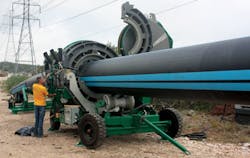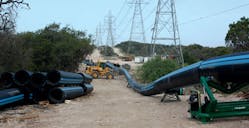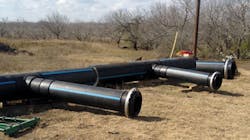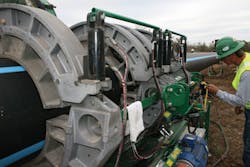By Stephen C. Cooper
With water supply a constant concern in its sub-tropical area, San Antonio Water System (SAWS) continues to find feasible ways to expand its operation. Due to the terrain and distance from available water sources to the city, the utility must install pipelines that are secure, economically feasible and free of leaks, as well as durable enough to be installed by cut-and-cover techniques and horizontal directional drilling (HDD).
Some of the pipe used for one project had walls that were 4 inches thick, and another used more than 23 miles of pipe. For both projects, SAWS found that high-density polyethylene (HDPE) pipe met the required criteria.
Solving the Tough Install Problem
For a new water main system northwest of the city, one HDD string of 36-inch-diameter HDPE pipe alone ended up being 1,000 feet long. This installation required a 20-foot entrance drop and exit rise so that pipe could be pulled under a creek. The water transmission main project here connected existing water mains with a new pump station built to accommodate future demands in the area.
"This new water main will connect the gap between the new pump station and the existing main to provide additional capacity for future growth in our city," said Juan G. Rodriguez, P.E., a project engineer in the production and transmission engineering department for SAWS. "It goes through a very rough area that has a lot of rock and ravines -- not the easiest terrain to bore through, let alone for a 36-inch-diameter pipe. Plus, we had to deal with an active creek. The HDPE pipe is tough and provides the type of deflection you need for directional drilling and has the best cost effectiveness."
"This was a very challenging installation but perfect for HDPE pipe," said Tony Radoszewski, president of the Plastics Pipe Institute, Inc. (PPI), the major trade association representing all segments of the plastic pipe industry. "And it's not a typical HDD/HDPE pipe project, because SAWS elected to use very thick-walled pipe -- greater than 4 inches in thickness -- in a larger diameter size to meet its design specifications. But, even at this extreme, the HDPE pipe installed easily and delivered a highly sustainable, completely leak-free system with fused joints. These characteristics are the norm when using HDPE pipe."
Pressure class for the system is 200 psi, which provides enough power for the distance between pumping stations, the area's elevation, and the number of projected customers. "This pressure zone is located on those higher elevation areas in San Antonio's hill country, so the water has to travel up as well as far," Rodriguez said.
The project needed more than 1,900 linear feet of HDPE pipe, with three sections requiring three HDD pulls. "They were labeled Line A, B and D," said Bob Gajeske, Jr., whose company, Gajeske, Inc. (Grand Prairie, Texas), supplied the pipe and also did the fusion. "Line B is the longest pull -- it was almost 1,000 feet long alone." But, Gajeske said that they didn't experience any problems fusing the pipe. "We just had one operator on the fusion machine -- a McElroy 1600, with a four-jaw clamp and hydraulic lift. That 65-inch unit had absolutely no trouble clamping, facing or fusing that pipe at all -- it worked just as easily as when we fuse HDPE pipe in smaller diameters with thinner walls."
Imperative to the success of the project was the ability to utilize HDD for specific areas. "It was essential that we circumvent that creek [with] HDD as the only option," said Rodriguez. "We couldn't dig a trench due to the steep terrain, and you can't have the water main exposed, especially on these types of creeks in Texas, which are known for flooding and washout conditions. So we had to go under the surface, which required going down more than 20 feet, then horizontally under the creek. We did the same for the other areas that were just ravines."
The Marathon Pipeline
In 2013, SAWS tapped into another source to take care of its growing population. This source, however, was miles away, requiring a long-life pipeline that was nearly as long as a marathon running event.
The $149-million Regional Carrizo Project now provides water to 60,000 homes. For years, the city had received more than 90 percent of its water from the Edwards Aquifer. This project enables SAWS to also tap into the Carrizo Aquifer, located approximately 50 miles from San Antonio. Up to 13 million gallons per day (MGD) of water produced from this well field is transported by the new HDPE pipeline to an integration point in Northeast San Antonio where it will enter the SAWS distribution system. SAWS used more than 23 miles of HDPE pipe in 18-, 24-, 30-, and 36-inch-diameters to bring the water from the aquifer to the integration point. It is the largest HDPE pipe project of its type ever constructed in North America according to PPI.
"The numbers alone are exciting for this project," said Radoszewski. "It used 122,000 feet of HDPE pipe ranging from 18 to 36 inches in diameter, which made it the largest HDPE water pipe project in North America. There were 328 truckloads of HDPE pipe made from PE 4710 resin (an advanced grade of HDPE resin) that totaled some 11 million pounds." But it's not just about the numbers, he said. There were also some staggering performance challenges.
"Because of the super-heated temperature of the water and soil, the project was originally designed to use steel and ductile iron pipe," said Radoszewski. "But SAWS conducted additional analysis of the requirements that included longevity, installation, material, and labor costs, and the change was made to HDPE pipe. It installs quickly and easily, can stand up to virtually any environment for a projected lifespan of 100 years and delivers a highly-sustainable, leak-free system with fused joints, making it a one-piece pipeline."
The durability of HDPE allowed it to curve and maneuver around trees and obstructions over the 23 miles, causing minimal environmental disturbance. The ability to field bend the HDPE pipe meant not having to purchase elbows, which saved money. Pipe sections were fused aboveground in long lengths ahead of the installation crew, which further reduced the overall cost and required less work in the ditch, therefore making it safer.
"Quality control and on-site testing were important issues for SAWS," said Camille Rubeiz, P.E., director of engineering for PPI's Municipal Division. "These extra steps would have been very costly to do for coated steel pipe. HDPE proved to be a leak-free material, with no cathodic protection required, leading to lower maintenance costs, which was critical given the remote location of the project."
The pipe was made from PE 4710 and was selected for its high temperature and pressure capacity. According to Rubeiz, "PE 4710 allows for the maximization of pipe performance in a system, bringing an excellent level of slow crack growth resistance and enabling a piping system to be operated at high pressure and temperatures without sacrificing safety or service life. Use of PE 4710 also permitted different dimensional ratio (DR) rating ranges of the pipe to be used, which maximized cost savings."
PPI considers the SAWS potable water pipelines as teaching tools for the industry. "These large, municipal projects with extreme requirements will serve as proven examples of how to conquer uncommon requirements in size, scope and application," said Radoszewski. "Now industry benchmarks, they will help increase widespread use and adaption of HDPE piping materials to other large-scale municipal projects."
For more information, visit the Plastics Pipe Institute website at www.plasticpipe.org.
About the Author: Stephen C. Cooper reports on water industry events. A veteran writer, he has visited and conducted news interviews at hundreds of construction sites and plants both domestically and overseas.
More WaterWorld Current Issue Articles
More WaterWorld Archives Issue Articles








